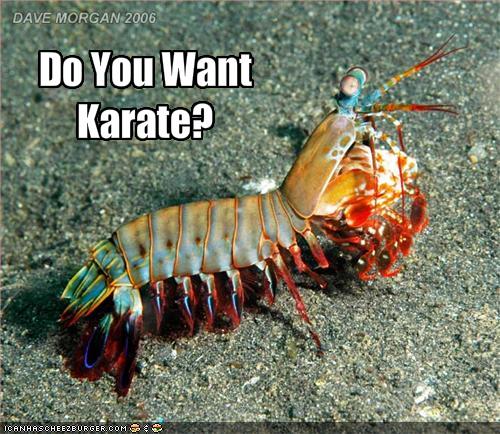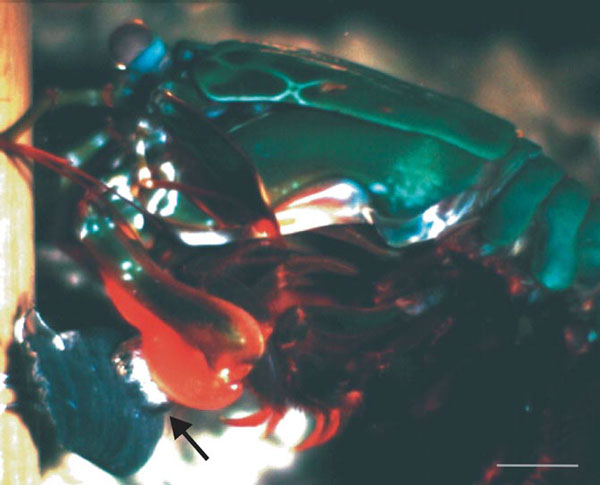It’s not easy to move fast. I say this not just out of laziness. The fact is, in the animal kingdom, moving quickly comes at a considerable energy expense. It also tends to wear down muscles and joints. So you can be pretty sure that whenever you see an animal that’s clocking in at a record speed, it’s doing so for a very, very good reason.
Take the case of the mantis shrimp. These incredible crustaceans come in two varieties: stabbers, and smashers. Sheila Patek is a biologist who studies them for a living. In a fascinating TED talk from 2004, she describes how mantis shrimp have the fastest blow in the animal kingdom. Their strike force is so great that it creates a visible shock wave in water, in a bizarre phenomenon known as cavitation. Patek goes on to describe the engineering solutions that these animals use to create and sustain their powerful smash.

Since 2004, the list of nature’s fastest has had more than a few additions. It’s the time of the year for holiday lists, so I decided to list some of the most impressive record holders in this regard. To do this, I relied mainly on references I found on the wonderful website of Patek’s lab.
The life forms that follow are pushing the limits of physics and engineering. Typically, they are doing this to rein death and terror onto hapless prey. They are the Terminator 2’s of our world. So please join me, as we descend down this list towards the most lethal of all blows. This is a quest for the fastest draw in nature.
But first, let’s start with something fast that we’re familiar with. When talking about short intervals of time, we often use the phrase ‘in the blink of an eyelid’. The time it actually takes us to blink an eyelid is about 3 tenths of a second or 300 milliseconds.
A blink of an eye (300 milliseconds)
So, our first point of reference is 10 milliseconds, or 1/30th of a blink of an eye
The ballistic tongue of the salamander (< 10 milliseconds)
The explosive tongue of the giant palm salamander of Central America bursts out in under 10 milliseconds, targeting flying bugs that don’t know what hit them. To achieve this feat, the tongue of this cold blooded sniper needs to output energy at the rate of a whopping 18,000 Watts per kilogram of muscle.
It stores this energy like a tightly coiled spring. As it relies on the principle of a slingshot, it can even operate in cold temperatures when muscles are slow to contract.
This tongue has been called the world’s most powerful muscle, but it’s no comparison to what follows.
The vacuum suction of the anglerfish (<5 milliseconds)
An anglerfish has what seems like a rather improbable fishing strategy.

It lures its prey in with a shiny dangling object attached to its head. All of a sudden, its mouth expands to more that 12 times its original size. The low pressure region thus created sucks in water at great speed, as well as whatever unfortunate fish happens to be swimming nearby. It’s a process that looks alarmingly like this.
And this strange kiss of death can take place in less than 5 milliseconds, or 1/60th of a blink of an eye.
The blinding strike of the mantis shrimp (2.7 milliseconds)
This has to be one of the most impressive punches in nature.
Sheila Patek and collaborators measured that the blow of the mantis shrimp can reach a peak speed of 51 mph (23 m/s), in less than 1/100 of the blink of an eye. All this while underwater! It’s so fast that it actually creates a visible shock wave. Meanwhile, its limb experiences over 10,000 g of acceleration.

To put this number in context, think of this: a typical person can handle an acceleration of about 5 g before losing consciousness, while decelerations of 100 g are about the highest that humans have survived, in Indy car racing accidents. A bullet shot out of a Beretta gun is accelerated by about 40,000 g.
If you were a snail or a clam, this could well be the last thing that you see:
Needless to say, a mollusk doesn’t stand much of a chance against this punch. The muscle that powers this impressive blow is delivering a mind-numbing 470,000 Watts per kilogram. It’s quite literally blowing the competition out of the water.
Well.. not quite. Read on.